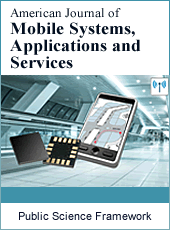American Journal of Mobile Systems, Applications and Services
Articles Information
American Journal of Mobile Systems, Applications and Services, Vol.1, No.1, Aug. 2015, Pub. Date: Jul. 15, 2015
Adaptive Interference Reduction in the Mobile Communication Systems
Pages: 12-19 Views: 3045 Downloads: 1219
[01]
Isiaka A. Alimi, Department of Electrical and Electronics Engineering, School of Engineering and Engineering Technology, Federal University of Technology, Akure, Nigeria.
[02]
Oluyomi Aboderin, Department of Engineering and Space Systems, National Space Research and Development Agency, Abuja, Nigeria.
The multipath fading has been observed as one of the major issues in wireless systems particularly in the mobile communication systems. Its effect leads to significant impairment in the signal received by the mobile units. This necessitates the need to take multipath fading into consideration in designing an effective radio communication system by implementation of schemes which enable the effects to be minimized. Rake receiver has been observed as a viable solution to reduce multipath effect in wideband code division multiple access (WCDMA) systems. The implementation of Rake receiver gives better performance in terms of the bit error rate (BER) and the associated system throughput. However, Rake receiver consists of sub-component which increases the system computations and also brings about high power consumption. In this paper, we proposed a simplified system that is based on ordered successive interference cancellation (OSIC) which is a feasible scheme in a real-time mobile scenario to reduce multipath effect and multi-user interference. The simulation results obtained show significant performance improvement in symbol-error-rate (SER) over different signal-to-noise ratio (SNR) considered.
Wideband Code Division Multiple Access (WCDMA), Third Generation (3G), Rake Receiver, Multiuser Detection (MUD), Ordered Successive Interference Cancellation (OSIC)
[01]
R. Manish and S. S. Amanpreet, “Performance evaluation of Rake and pre-Rake receiver for a wireless DSCDMA system,” International Journal of Engineering and Technology, vol. 2 no. 7, pp. 1333-1335, July, 2012.
[02]
G. E. Bottomley, T. Ottosson, and Y. E. Wang, “A generalized Rake receiver for interference suppression,” IEEE Journal on Selected Areas in Communications, vol. 18, no. 8, pp. 1536-1545, August 2000.
[03]
T. Ojanperä and R. Prasad, Wideband CDMA for Third Generation Mobile Communications, Norwood MA, USA: Artect House Inc, 1998, pp. 439.
[04]
H. Lee and D. S. Ha, “An area and power efficient Rake receiver architecture for DSSS systems,” in Proc. 2003 IEEE International SOC Conference, Portland, Oregon, pp. 103-106.
[05]
G. Fock, J. Baltersee, P. Schulz-Rittich, and H. Meyr, “Channel tracking for Rake receivers in closely spaced multipath environments,” IEEE Journal on Selected Areas in Communications, vol. 19, no. 12, pp. 2420- 2431, Dec. 2001.
[06]
Y. Sung and Y. Lim, L. Tong and A. Veen, “Signal processing advances for 3G WCDMA: from Rake receivers to blind techniques,” IEEE Communications Magazine, vol.47, no.1, pp.48-54, January 2009.
[07]
P. Kumar, B. K. Kanaujia and M. Gangadharappa, “BER performance analysis of Rake receiver in Rayleigh fading channel for UMTS environment,” International Journal of Engineering Science and Technology, vol. 2, no.6, pp. 1690-1698, June 2010.
[08]
K. Ohno, M. Itami and T. Ikegami, “Iterative Rake reception scheme using multi-carrier pulse for pulse based UWB system,” in Proc. 2013 IEEE International Conference on Ultra-Wideband, Sydney, NSW, 2013, pp. 249-254.
[09]
Gu, Jiaqi, R. C. de Lamare, “Joint parallel interference cancellation and relay selection algorithms based on greedy techniques for cooperative DS-CDMA systems,” in Proc. 2014 IEEE International Conference on Acoustics, Speech and Signal Processing, Florence, Italy, 2014, pp. 2754 - 2758.
[10]
T. S. Rappaport, Wireless Communications Principles and Practice, Prentice Hall, New Jersey, 1996, pp. 336-338.
[11]
K. M. Krishna, A. Mitra and C. Ardil, “A simplified single correlator Rake receiver for CDMA communications,” International Journal of Electrical, Robotics, Electronics and Communications Engineering, vol. 4, no. 2, pp. 13-16. 2010.
[12]
A. Richardson, WCDMA Design Handbook, Cambridge University Press, 2005
[13]
I. A. Alimi, J. J. Popoola, K. F. Akingbade, M. O. Kolawole, “Performance analysis of bit-error-rate and channel capacity of MIMO communication systems over multipath fading channels,” International Journal of Informatics and Communication Technology, vol. 2, no. 2, pp. 57-63, July 2013.
[14]
J. Zhan, B. Nazer, U. Erez and M. Gastpar, “Integer-forcing linear receivers,” in Proc. 2010 IEEE International Symposium on Information Theory Proceedings, Austin, TX, 2010, pp. 1022 - 1026.
[15]
W. Qu, K. Niu, Z. He, and J. Lin, “A low complexity approach of chip-level MMSE equalization,” in Proc. 2013 IEEE 5th International Symposium onMicrowave, Antenna, Propagation and EMC Technologies for Wireless Communications, Chengdu, 2013, pp. 500 - 504.
[16]
J. Ming and L. Hanzo, “Multiuser MIMO-OFDM for next-generation wireless systems,” Proceedings of the IEEE, vol. 95, no. 7, pp. 1430-1469, July 2007.
[17]
V. Namboodiri, H. Liu and P. Spasojevic´, “Successive interference cancelation and MAP decoding for mobile MIMO OFDM systems and their convergence behavior,” EURASIP Journal on Wireless Communications and Networking, vol. 2012, pp. 1-12, October 2012.

ISSN Print: 2471-7282
ISSN Online: 2471-7290
Current Issue:
Vol. 5, Issue 1, March Submit a Manuscript Join Editorial Board Join Reviewer Team
ISSN Online: 2471-7290
Current Issue:
Vol. 5, Issue 1, March Submit a Manuscript Join Editorial Board Join Reviewer Team
| About This Journal |
| All Issues |
| Open Access |
| Indexing |
| Payment Information |
| Author Guidelines |
| Review Process |
| Publication Ethics |
| Editorial Board |
| Peer Reviewers |


